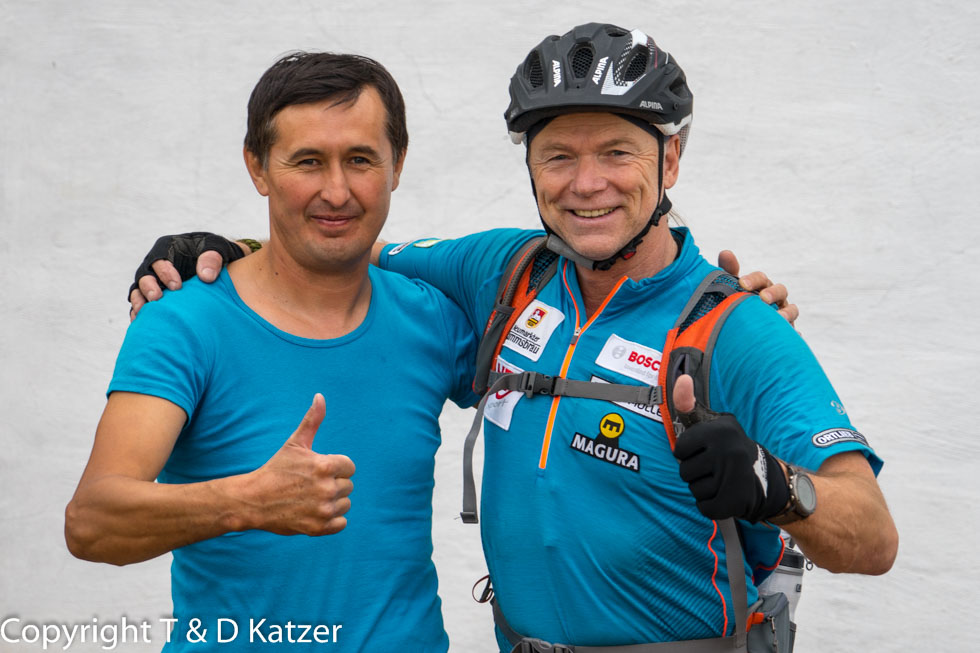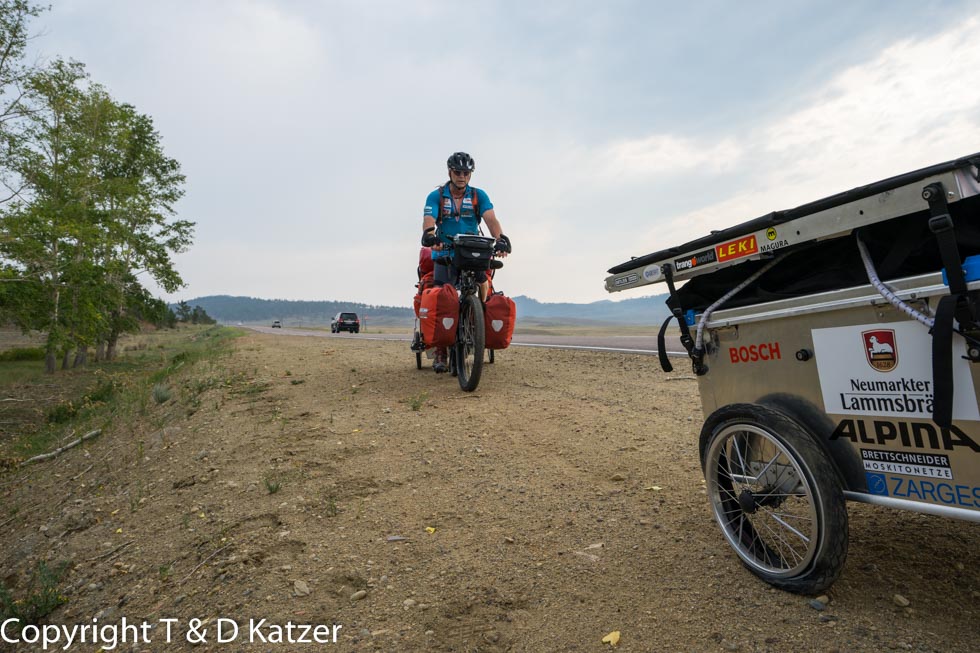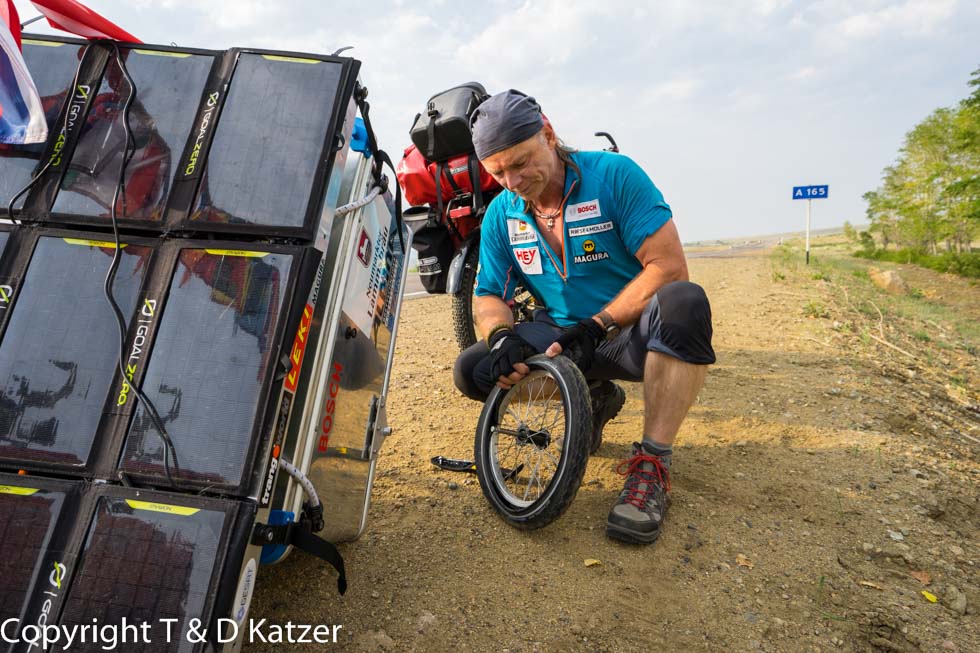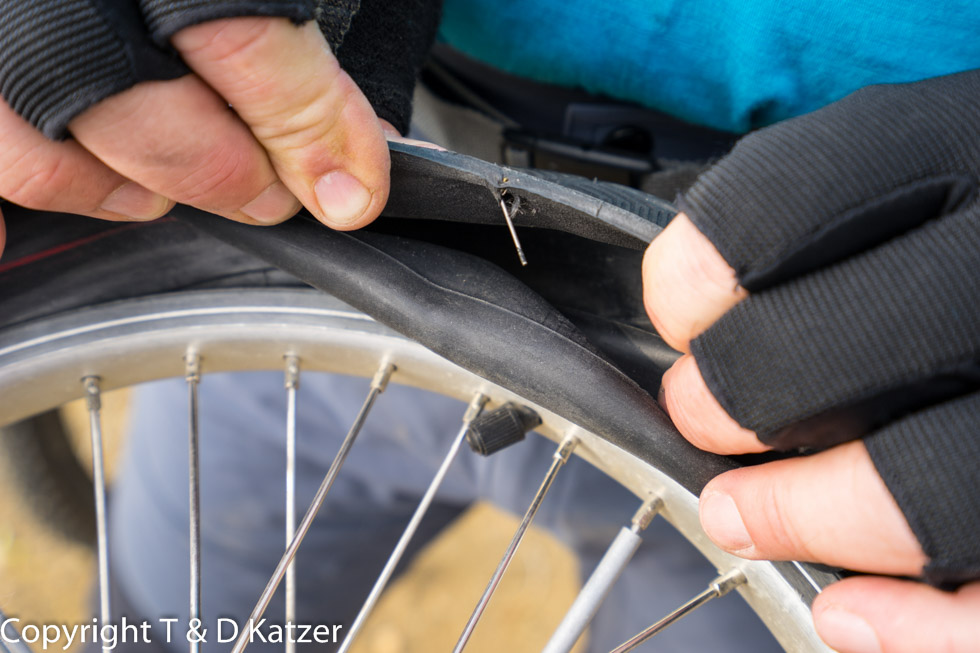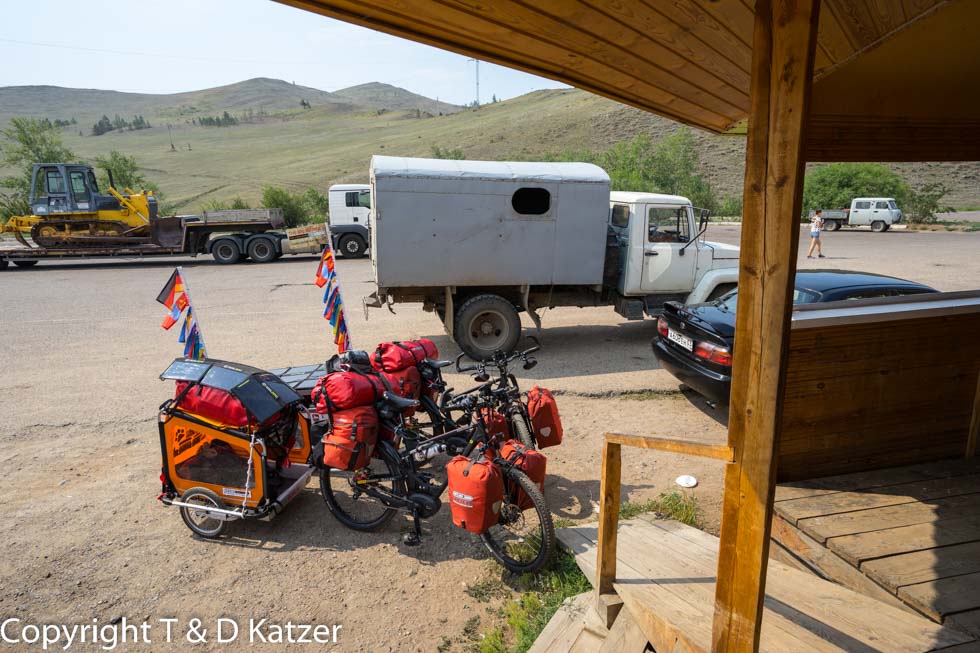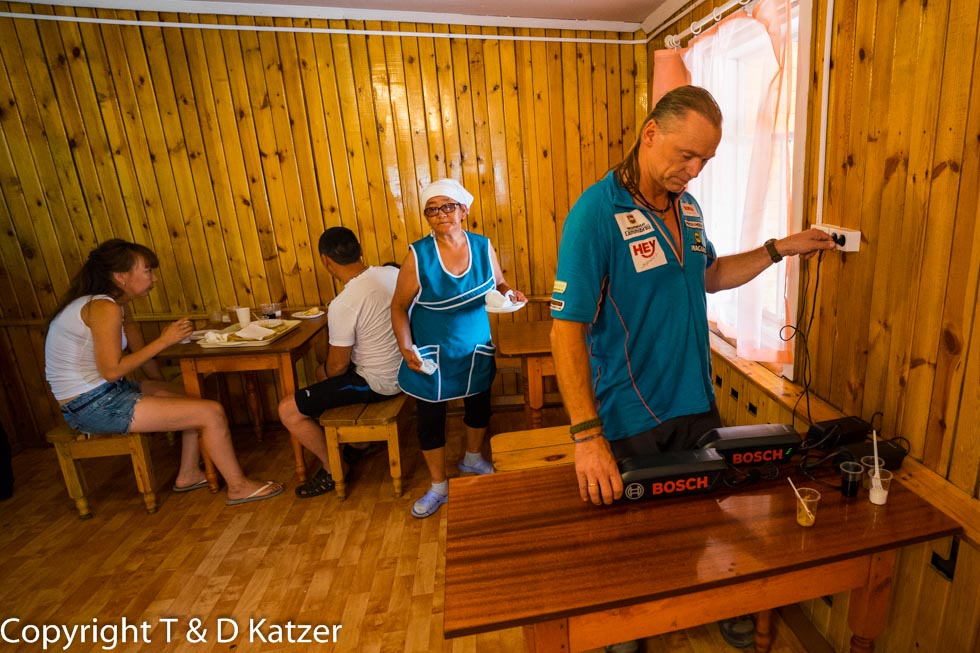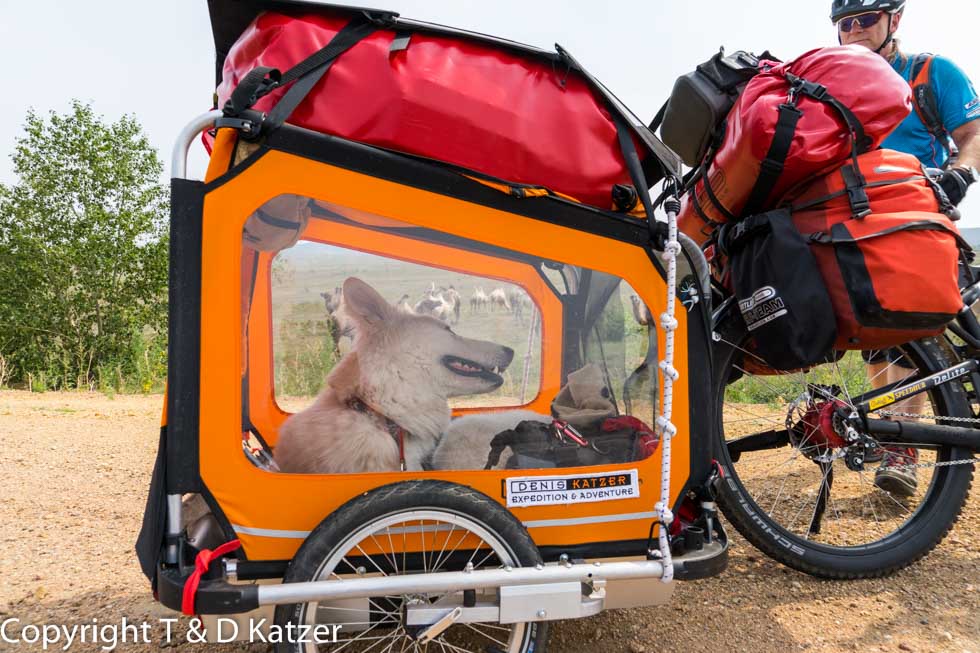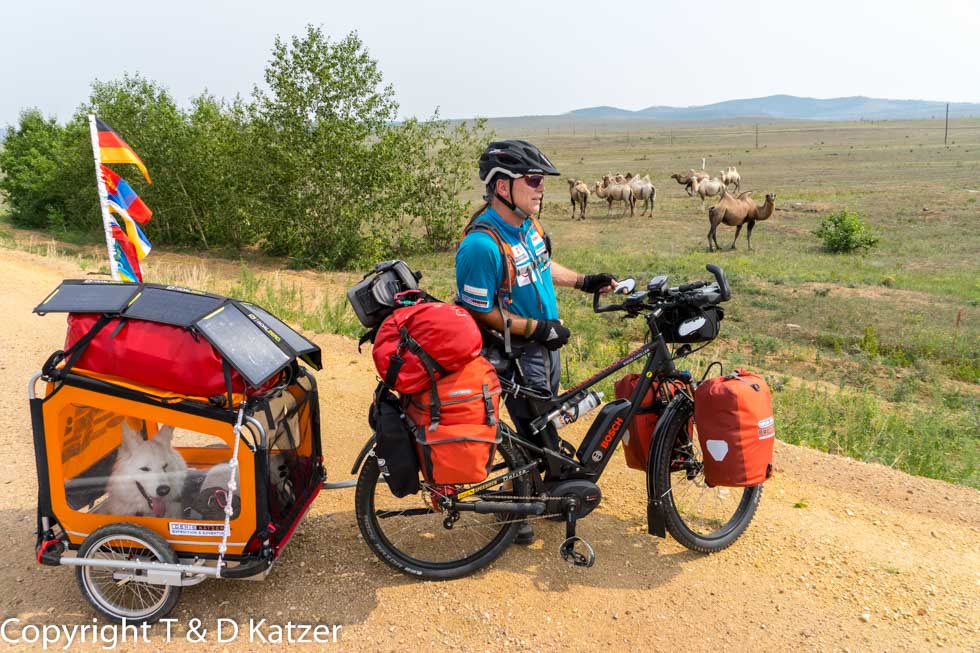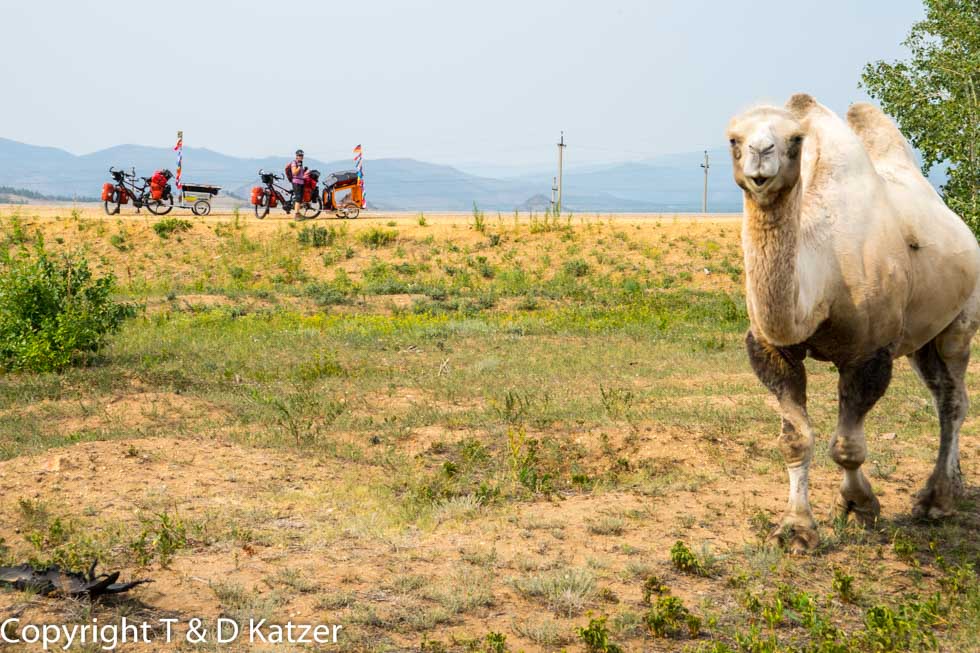
83 km route, unexpected challenges and breakdowns
N 51°17'16.9'' E 106°32'02.9''
Day: 25
Country:
Russia / Siberia
Location:
Gusinoosjorsk
Latitude N:
51°17’16.9”
Longitude E:
106°32’02.9”
Kilometers per day:
83
Total kilometers:
8,169
Aver. Sib.
20.4 km/h
Temperature day max:
50 ° in the sun
Departure:
7:10 a.m.
Arrival time:
5:30 pm
(Photos of the diary entry can be found at the end of the text).
Because of the merciless heat, we decided to get up at 5:00 a.m. today. Tired but full of energy, I swing my legs over the bed frame. Then we have a nutritious breakfast porridge and a cup of black tea. At 5:45 a.m. I wake Boris so that he can unlock the door for us. “Dobre utra Boris” (Good morning) is how I greet him. “Dobre utra Denis. I hope you slept well?” “A bit hot, but with cold calf wraps it went quite well.” “Calf compresses?” he asks, almost collapsing with laughter. He gives us a picture of the nearby monastery and of the holy monk whose body has miraculously remained fresh to this day. “If you come by here again, you’ll be my guests,” he invites us with an open laugh. “I’d love to,” I say and hand him an autograph card, of which we have a few for cases like this. “But it absolutely has to have a signature on it,” he asks. Then we pose in front of his Gastiniza for a farewell photo, shake hands vigorously and push the heavy bikes out of the yard. Boris follows us to the road and waves after us for a while. We quickly left Ivolginsk behind us. At the moment we’re a bit braver with the gears and use the Tour and sometimes even Sport levels. Although this reduces the energy consumption of the batteries more quickly, yesterday showed us that we can cover more than 30 km on a straight route with the easy Eco setting. Our destination today is the small town of Gussinoosjorsk. It is just over 80 km to that point. As there are still few hiding places in the foothills of the Chamar Daban Mountains to set up a safe camp, we are forced to take this route. For our then heavily laden bikes without electric assistance, this was an achievement that demanded everything from us, even though we were absolutely fit. Fortunately, the headwind is not blowing in our faces at 40 km/h like it was years ago. On the contrary, it is rather calm on this day. “What fun!” exclaims Tanja. We enjoy the beautiful landscape. At times, the road leads through wide valleys with only slight elevations, whose adjacent mountain ranges are still overgrown by the eternal taiga. Here, however, it is visibly being pushed back by forest fires. Extensive brown aisles stretch across the mountain ridges like nasty, incurable wounds. The sight is painful and shows that even the large taiga is being pushed back more and more. What remains are treeless hills, some of which are only covered in grass. Surprisingly, Tanja lags behind despite the e-bike drive. “You just have to shift up a gear higher than me! Then we can ride at the same speed,” I call out to her. “I don’t want to use too much electricity!” she replies, and the distance between us increases. I start to get a little annoyed. We already have e-bikes and yet I always have to wait. The classic when husband and wife are out and about on their bikes. Because I can only see my luggage in the rear-view mirror, I always have to turn around to see Tanja. My bike wobbles alarmingly every time. So I leave it for a while and drive along at around 20 km/h. However, an uneasy feeling makes me look back again. There is no sign of Tanja for miles around. A shock immediately runs through my limbs. Surely she didn’t fall off her bike on the last descent? Or did they get hit by a truck? Is there something wrong with the bike? “What a bummer. I shouldn’t have driven ahead!” I curse loudly and turn my Roadtrain around. With the turbo setting, I speed back at around 27 km/h, the maximum speed supported by the engine. Rounding a long bend, I concentrate on the left-hand side of the road. Surely she must show up? For God’s sake, don’t let anything happen, it goes through my head. Then I suddenly spot the wheel, but I can’t see it clearly yet. Is it standing? Is someone standing there? Please leave them. Yes indeed. As I get closer, I recognize her waving at me. That is a good sign. Then you can see her holding the camera in her hand and obviously taking pictures. That is a very good sign. So nothing serious has happened. But why is it there? My thoughts are racing. It’s amazing what can go through your head in such a short time. “What’s going on?” I shout impatiently at her. “A flat tire! The right tire of the trailer is flat,” her reply wafted to my ears as I recognized the damage. “It’s a good thing nothing happened to you. Hopefully you were able to brake as soon as you noticed it, otherwise the rim was damaged.” “Yes, it rumbled a bit down the hill, then I immediately applied the brakes.” “Good,” I say, putting my bike on the stand and examining the tire. “Unbelievable, it’s completely useless. Look at this. The wire of the sheath has torn and drilled into the hose. That’s not possible. The hole in the hose is the size of a fingernail and the air has suddenly escaped. It’s a good thing you stopped quickly, otherwise the rim would have been ruined. And that after just 46 km. Simply unbelievable.” “Do we have a spare tire with us?” asks Tanja. “Yes, two of them,” I reply and look for the matching hoses. “Damn it, I packed them in the big bag on Ajaci’s trailer, didn’t I?” I curse nervously because I can’t find them. “Maybe I just forgot to pack the hoses in the stress of preparation?” I ponder, trying to bring the stockpile of spare parts at home to life in my mind’s eye. “If that’s the case, we have a problem. A serious problem,” I realize and check the large Ortlieb bag once again. Then I find what I’m looking for. I simply overlooked it in the excitement. I quickly pull the new casing and tube onto the rim and inflate the tire. Before continuing, I also check the air pressure of the other tires. “Far too little everywhere. Funny, in Germany the air pressure was still okay. Maybe that was the reason why the coat came apart so badly. After all, there’s a lot of weight in the trailer,” I try to find an explanation. With final loading, repair and loading, I need over an hour. Then we continue our journey through the beautiful landscape.
“Are those camels up ahead?” asks Tanja. “Really! Camels!” I shout enthusiastically. We immediately stop to take photos of our favorite animals, with which we crossed Australia and many deserts during our big trip. They graze peacefully by the roadside and are not disturbed by passing cars.
At 11:30 a.m., various restaurants and trucker bars line the roadside. We decide to ask here for accommodation for the night. “There’s only a gastinitsa in Gusinoosjorsk,” is the disappointing answer. “Then we should eat something here and rest for a while,” Tanja suggests. We park our bikes directly in front of one of the street cafés. “Can we use your power socket?” I ask the Dewuschka (woman) standing behind a counter serving food. “Moschna”, (you may) she replies kindly. I immediately remove our batteries to charge them at the socket. “It’s best if we stay here until they’re full again. Then we can drive the remaining 50 km in turbo mode,” I suggest. “It’s a good idea,” says Tanja. We sit down on a wooden bench on the small covered terrace of the Gastiniza and enjoy the soothing shade. As soon as we come to rest, I am overcome by leaden tiredness. The exertion of the last few kilometers, the excitement of the supposedly missing tubes and the repairs take their toll. We fill our stomachs with the only dish on offer. The meat-filled dumplings called Posy taste delicious and, given the brisk sales, we are sure that the meat is fresh. “What kind of dog breed is that?” we are constantly asked. “What a beautiful dog. Can we stroke him? Can we take a photo?”, the visitors to the street café ask us. The time flies by.
Two hours later, we are back on our e-bikes to tackle the 50 km to the city. As agreed, we speed over the upcoming mountain ranges at full power. Now you can see what an e-bike can do. We ride along at 27 km/h and enjoy the rush of speed without puking our lungs out as usual. “It’s really amazing!” I shout and wonder why I don’t get an answer. “What’s going on? Are you all right?” “No one can keep up the speed you’re going. That’s impossible!” Tanja’s reply yelps to my ears. “What? Why is that? You have to switch to turbo!” “I did, but you’re still much too fast,” I hear behind me. “That’s not possible! We have the same systems,” I reply and stop. “Are you shifting gears properly?” “Of course, what do you think? But I still can’t keep up.” “Hm, I don’t know why that is. It’s a real shame. I thought we could drive the next 17,000 km through the countries at the same speed and with the same power. And now this. We’d better swap bikes to see if something is different with your e-bike than with mine.” “Okay,” she replies and we get back on the saddle after swapping bikes. “And is it any better?” I ask, chasing Tanja’s bike over the asphalt at the same speed as before. “No problem. Works great!” is the astonishing answer. “Really?” “Yes, much better than before.” I think for a while about what could be the reason for this and come up with the idea of comparing the speed information on the display with my GPS. The result surprises me again, but explains the problem. While my display shows the correct speed, Tanja’s is always 2 km/h faster. This means that if I drive at 26 km/h, she has to drive at 28 km/h. “I’ve got it!” I shout and explain to Tanja that the electronics cut the power supply to the motor at around 25 km/h. “Since we left the restaurant and were riding at full power, you had to pedal everything over 25 km/h under your own power. Of course, that’s a killer with that load. No wonder you couldn’t keep up,” I say. “Well, I’m glad about that. I thought you’d suddenly developed superhuman strength or that the Buryats had doped you with their dumplings.” “Certainly no doping in those things. They gave me heartburn,” I reply and think about why two identical systems display different information. As I continue my journey, deliberately keeping my speed at 23 km/h, I get an idea. “I think different tire sizes are programmed into the on-board computers. That could be the solution. I’ll try to change it tomorrow,” I explain. As soon as we pedal our steeds up a hill, Tanja’s bike grinds terribly. We stop again. “It’s the mudguard,” I realize, unpack the tool to adjust it and tighten the bolts. “The bad roads loosen all the screws,” I explain. We are just about to get back into the saddles when we catch sight of Ajaci’s trailer. It has slashed the entire fabric with its claws. Tanja spent many hours in Ulan Ude with the dog trailer to make it safe for Ajaci. So far it has been no problem for him to push his paws through the lower part of the mosquito net-like fabric. In the worst case scenario, his paws would hit the road during the journey and thus get under the trailer. In this situation, they would snap like matchsticks and that is exactly what must be prevented at all costs. “We should turn it 180 degrees,” Tanja suggests. “You mean if he looks backwards and not forwards he’s safer?” “Maybe.” I ponder Tanja’s suggestion and then we put it into practice. As soon as we are back on the road, a fat jeep stops us. We are stopping. A woman, a man and two children get out. “Where do they come from? From Germany? Malazee! (Fantastic). Can we take a photo with you?” they ask excitedly. “Of course,” we reply. Then we say goodbye to the Buryat family. “No more breaks now!” shouts Tanja, pedaling away.
10 ½ hours after we set off this morning, we arrive in the ugly and miserable little town of Gusinoosjorsk at 5:40 pm, after just over 4 hours of pure driving time, a few breakdowns and 83 km. Our bikes bump along the torn-up roads, which are lined to the left and right by poor, run-down communist prefabricated buildings. As we had already looked for accommodation here years ago, we quickly find the equally miserable Gastiniza, which is hidden in one of the ultra-ugly buildings. We park our bikes in the parking lot of a supermarket. While Tanja and Ajaci look after our belongings, I stagger into the building, a little groggy from the exertion. “Do you have a room?” “We do.” “Uh,” I start my next sentence, afraid of possibly being rejected. “We have two bikes and a dog. Can we store the bikes somewhere here?” “They can go under the stairs in the stairwell.” “Great, thank you very much.” “How big is your dog?” I’m still startled by her question. “Normalna”, (a statement for many situations e.g. okay, alright, or normal) I answer with presence of mind and think to myself that if I had told her that our dog weighs 35 kg and is more comparable to a small polar bear or even better to a big wolf, she would certainly have refused. “Can I see the room?” I ask when I’m sure that our dog is no longer an issue. “I follow her up the stairs and when we reach the fourth floor, I am overcome by the feeling that my thighs will burst at any moment. The lady shows me a small room in which there is only one bed. “No, we need a double bed or two beds,” I ask, whereupon we go back downstairs to get new keys. Once again I drag myself upstairs. This time I get to see an old but very clean room with two beds. “We’ll take that,” I decide and keep a firm grip on the banister as I go down the stairs so that I don’t simply fall off in the event of a thigh muscle failure. Tired but happy about my success in booking us into the shed with bikes, dog and trailer, I walk back to Tanja in the parking lot. “It’s on the fourth floor, but we’re inside,” I explain. “Great,” is the answer, whereupon we roll our possessions into the backyard of the old house. When the ladies at reception see Ajaci for the first time, their hearts almost slip into their pockets. But it only took a few moments for him to win their hearts. So much so that the ladies and the security guard let themselves be photographed with him until their cell phones run hot.
The live coverage is supported by the companiesGesat GmbH: www.gesat.com and roda computer GmbH www.roda-computer.com The satellite telephone Explorer 300 from Gesat and the rugged notebook Pegasus RP9 from Roda are the pillars of the transmission.
